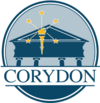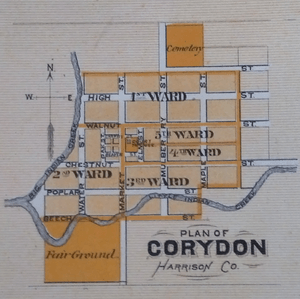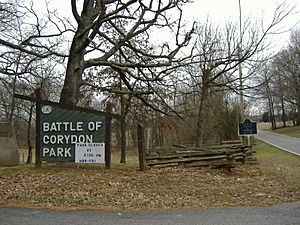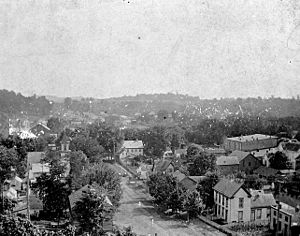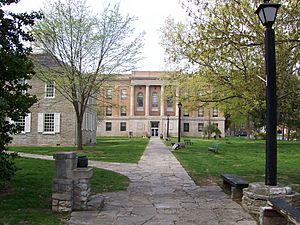Corydon, Indiana facts for kids
Quick facts for kids
Corydon, Indiana
|
|||
|---|---|---|---|
|
Town
|
|||
| Town of Corydon | |||

Downtown Corydon viewed from the Pilot Knob in the Hayswood Nature Reserve
|
|||
|
|||

Location of Corydon in Harrison County, Indiana.
|
|||
| Country | United States | ||
| State | Indiana | ||
| County | Harrison | ||
| Township | Harrison | ||
| Area | |||
| • Total | 1.64 sq mi (4.24 km2) | ||
| • Land | 1.64 sq mi (4.24 km2) | ||
| • Water | 0.00 sq mi (0.00 km2) | ||
| Elevation | 568 ft (173 m) | ||
| Population
(2020)
|
|||
| • Total | 3,153 | ||
| • Density | 1,927.26/sq mi (743.92/km2) | ||
| Time zone | UTC-5 (EST) | ||
| • Summer (DST) | UTC-4 (EDT) | ||
| ZIP code |
47112
|
||
| Area code(s) | 812 | ||
| FIPS code | 18-15256 | ||
| GNIS feature ID | 2396664 | ||
Corydon is a town in Harrison Township, Indiana. It is also the county seat of Harrison County, Indiana. Corydon is located north of the Ohio River in the southern part of the state.
The town was founded in 1808. It was the capital of the Indiana Territory from 1813 to 1816. Corydon was also the site where Indiana's first constitution was written. This happened from June 10 to June 29, 1816. Forty-three delegates met to decide if Indiana should become a state. They wrote the first state constitution.
Corydon was the capital of Indiana until 1825. Then, the state government moved to Indianapolis. In 1863, during the American Civil War, Corydon was the site of the Battle of Corydon. This was the only official battle fought in Indiana during the war. Today, Corydon has many historic sites. These sites make it a popular place for tourists to visit. Part of its downtown area is listed as a historic district. In 2010, Corydon had about 3,122 people living there.
Contents
History of Corydon
Early Days of Settlement
After the American Revolution, the area around Corydon became part of the United States. The first American families settled in Harrison County around 1792. These included the families of Harvey Heth and Squire Boone. They had to leave for a while because of conflicts with Native Americans. They returned in 1800 when the Indiana Territory was created.
The government surveyed the land for Corydon in 1807. The first official land sales happened in April of that year. Edward Smith and his family were the first Americans to live in the area in 1803. They bought the land they were already living on. Their home was near a large spring, where the county fairgrounds are today.
William Henry Harrison was the first governor of the Indiana Territory. He later became a U.S. president. Harrison often stopped at the Smith family's home when traveling. In 1804, Harrison bought land where two creeks, Big Indian Creek and Little Indian Creek, meet. He decided to build a town there.
The town's name, Corydon, comes from a hymn called "The Pastoral Elegy." This hymn is about a shepherd named Corydon. People say Harrison asked Edward Smith's daughter, Jenny, to name the town. She chose the name from Harrison's favorite hymn.
Harrison sold the town site to Harvey Heth in 1807. Corydon was officially founded in 1808. That's when Heth, a government surveyor, planned out the town. He gave the town square for public use. He sold other lots to settlers and the government. When Harrison County was formed in 1808, Corydon became its county seat.
Corydon quickly grew into an important settlement in Indiana. It was a main stop on the only land route to Vincennes, the territorial capital. During the War of 1812, Corydon sent a group of soldiers called the Yellow Jackets. They fought in the Battle of Tippecanoe. They had more casualties than any other group.
Corydon as Territorial Capital (1813–1816)
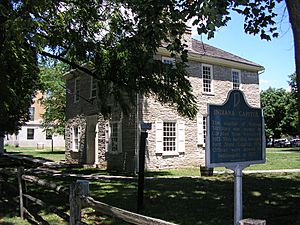
Corydon became the second capital of the Indiana Territory on May 1, 1813. The capital moved from Vincennes. People who didn't like the former governor, William Henry Harrison, wanted the capital moved. They wanted it away from his power base in Knox County. Also, moving the capital east made it more central for citizens. This was especially true after the Illinois Territory was formed in 1809.
Corydon competed with other towns to become the new capital. Dennis Pennington, a representative from Harrison County, helped Corydon get chosen. He said Corydon was a great spot. A new county courthouse was being built in Corydon. It could be used for the territorial legislature. Pennington oversaw the building of this limestone courthouse. It was almost done when Indiana's first state legislature met there in 1816. Before that, the territorial legislature met in the original county courthouse.
In 1814, Paul and Susannah Mitchem, who were Quakers, moved to Harrison County. They brought 107 enslaved people with them and freed them upon arrival. Most of these freed people settled around Corydon. This group became one of the largest communities of free Black people in Indiana.
Indiana's First Constitution (1816)
On April 19, 1816, President James Madison signed a law. This law allowed Indiana to elect people to a meeting in Corydon. Their job was to decide if Indiana should become a state. Forty-three delegates met from June 10 to June 29, 1816. They wrote Indiana's first state constitution. The constitution says they met "at Corydon, on Monday the tenth day of June in the year of our Lord eighteen hundred and sixteen."
The delegates met in a log cabin near the courthouse. It was unfinished and hot. So, they often went outside under a huge elm tree. This tree was later called the Constitution Elm. The tree died in 1825, but part of its trunk is saved. It's surrounded by a sandstone memorial built in the 1930s. The delegates finished their work in just nineteen days. The new state constitution started on June 29, 1816. It said Corydon would be the state capital until 1825.
Being chosen as the capital made Corydon grow fast. There weren't enough places for visitors to stay. A much larger inn, the Kintner House Tavern, opened in 1819. Many officials, including three governors, moved to Corydon. Important national figures also visited, like President James Monroe and Andrew Jackson in 1819.
Corydon as State Capital (1816–1825)
On November 4, 1816, the Indiana General Assembly met in Corydon for the first time. This was under the new state constitution. President James Madison signed a resolution on December 11, 1816. This made Indiana the nineteenth state in the Union. Corydon then became Indiana's first state capital.
The Harrison County courthouse is now known as the Old Capitol. It was Indiana's first state capitol building. State government offices were there from 1816 to 1825. Other historic buildings in Corydon are from this time. These include the Governor's Mansion and the Old Treasury Building. The Old Treasury Building was Indiana's first state office building, built in 1817. Corydon's Grand Masonic Lodge, the first in the state, was built in 1819.
Many important politicians lived in Corydon during this time. These included two Indiana governors, Jonathan Jennings and Ratliff Boon. Also, Dennis Pennington, the first Speaker of the Indiana Senate, lived there. William Hendricks, Indiana's first U.S. Representative and later governor, also lived in Corydon.
Many people didn't like Corydon being the state capital. They thought it was too far south as the state's population grew north. But Dennis Pennington and others kept the capital in Corydon until 1825. Governor Hendricks signed a bill in 1824 to move the capital to Indianapolis. This move happened on January 10, 1825.
After the Capital Moved
After the state government moved in 1825, Corydon remained the county seat. It was also a market town for local farms. In 1826, a new County Clerk's office was built. This was the main county office until 1848. Early on, people used the creeks for drinking water and bathing. This led to a cholera outbreak in 1832. After that, people dug wells for drinking water. In 1836, the town started putting gravel on its dirt roads.
In 1848, a new two-story brick office building was built. It was next to the county courthouse. This building was used until 1881. From September 11–14, 1860, the first annual county fair was held. It took place on Corydon's 36-acre fairgrounds. The fair has happened every year since 1860. This makes it the longest running county fair in Indiana.
Battle of Corydon (1863)
During the American Civil War, Corydon was the site of Indiana's only "official pitched battle." On July 9, 1863, Confederate General John Hunt Morgan and his cavalry crossed the Ohio River. This started "Morgan's Raid" into Indiana. About 450 local home guard members tried to stop them. But the Union forces were quickly defeated. The town then surrendered.
Corydon was attacked in return for Union looting in Kentucky. The town's money, $690, was taken. Prisoners from the local jail were also set free. General Morgan demanded money from mill and shop owners. He asked for $600 to $700 from each to prevent their buildings from being burned. A story says one miller paid too much. Morgan gave him back the extra money.
Corydon After the Civil War
In 1871, local reporters wrote about the poor condition of the first Indiana statehouse. It was dirty and full of pests. Many people didn't want to go inside. Their efforts worked. In 1873, the building was greatly improved. Walls were replastered, new stairs and furniture were added, and it was cleaned.
In 1881, the county started building its third office building. It was finished in June 1882 and used until 1929. The state of Indiana bought the 1816 courthouse to save it as a historic site. Starting in 1882, a railroad connected Corydon to other towns. This was an 8-mile spur of the Southern Railway.
A big fire happened in 1871. The Kintner House Tavern and a whole block of buildings were destroyed. The county jail also burned. Another major fire broke out in Corydon on April 20, 1883. It destroyed seven businesses, stables, and many homes. The fire slowed down in a lumber yard with fresh wood. This allowed people to put out the fire. Most of the western part of town was burned. It took until 1922 for all the lots to be rebuilt.
In 1917, Indiana bought the historic capitol building to restore it. The building opened as a state memorial in 1929–30. It is part of the Corydon Capitol State Historic Site. The Harrison County government used the old statehouse until 1929. That's when a new, three-story county courthouse was finished. It is located north of the original 1816 courthouse.
In 1960, a fire destroyed much of the Harrison County Fairgrounds. This included its grandstand. A new grandstand was brought from a baseball field in Louisville, Kentucky. It is still used today.
In 1969, Samuel P. Hays, a historian born in Corydon, gave 311 acres of land to the county. This land is now the Hayswood Nature Reserve. It is the county's second largest nature reserve.
In 1973, part of Corydon's downtown area was listed as a historic district. This is called the Corydon Historic District. It includes important sites from when Corydon was a capital. These are the Old Capitol, Constitution Elm, and the first state office building. In 1989, more buildings were added to the historic district.
In 2008, Corydon celebrated its 200th birthday. They had many events, including showing a bronze statue. It was of Honorable Frank O'Bannon, a former governor of Indiana and a citizen of Corydon.
Geography and Location
Corydon is located near the center of Harrison County. Indiana State Road 62 goes through the town from east to west. Interstate 64 passes just north of the town. The state capital, Indianapolis, is about 120 miles north. The city of Louisville, Kentucky is about 25 miles to the east. Indian Creek flows through the town. It then goes southwest and empties into the Ohio River.
According to the 2010 census, Corydon covers about 1.65 square miles of land. There is no water area within the town limits.
Population and People
| Historical population | |||
|---|---|---|---|
| Census | Pop. | %± | |
| 1850 | 462 | — | |
| 1870 | 747 | — | |
| 1880 | 763 | 2.1% | |
| 1890 | 880 | 15.3% | |
| 1900 | 1,610 | 83.0% | |
| 1910 | 1,703 | 5.8% | |
| 1920 | 1,785 | 4.8% | |
| 1930 | 2,009 | 12.5% | |
| 1940 | 1,865 | −7.2% | |
| 1950 | 1,944 | 4.2% | |
| 1960 | 2,701 | 38.9% | |
| 1970 | 2,719 | 0.7% | |
| 1980 | 2,724 | 0.2% | |
| 1990 | 2,661 | −2.3% | |
| 2000 | 2,715 | 2.0% | |
| 2010 | 3,122 | 15.0% | |
| 2020 | 3,153 | 1.0% | |
| U.S. Decennial Census | |||
2010 Census Information
In 2010, Corydon had 3,122 people living there. There were 1,341 households and 716 families. The town had about 1,892 people per square mile. Most of the people were White (96.7%). A small number were African American (0.7%), Native American (0.2%), or Asian (0.2%). About 2.6% of the population was Hispanic or Latino.
About 26.2% of households had children under 18. About 35.6% were married couples. Many households (46.6%) were not families. The average household had 2.14 people. The average family had 2.88 people.
The average age in Corydon was 40.8 years old. About 20.5% of residents were under 18. About 23.4% were 65 or older. The town was 45.6% male and 54.4% female.
Education in Corydon
Corydon is part of the South Harrison Community Schools district. The town also has a public library. It is a branch of the Harrison County Public Library.
Arts and Culture
Corydon is a popular tourist spot in southern Indiana. This is because of its many historic sites and events. The town has weekly events from spring to fall. These events are usually held around the historic town square.
Some local events include:
- An annual Halloween Parade.
- The Harrison County Fair.
- Friday night band concerts in the summer.
- An annual reenactment of the Battle of Corydon.
- Country and bluegrass music shows.
The weeklong county fair is held in June. It's one of Corydon's most popular events. Over 3,000 people usually attend each night. The fair has 4-H exhibits, rides, demolition derbies, and music.
Historic Places to Visit
- Old Capitol, Indiana's first state capitol building.
- Governor Hendricks' Headquarters, a former home of Governor William Hendricks.
- Constitution Elm Memorial, honoring the tree where Indiana's constitution was drafted.
- Old Treasury Building, Indiana's first state office building.
- Coburn-Porter Law Office, a former law office.
- Posey House.
- Battle of Corydon Memorial Park.
- The Kintner House Inn.
- Branham Tavern, a tavern that opened in 1809.
- Westfall House, the oldest home still standing in town.
- Kintner-McGrain House (Cedar Glade).
- Leora Brown School.
- Heth House.
- Cedar Hill Cemetery.
- Flags Over Corydon.
- Harrison County Fairgrounds.
Local Media
The Corydon Democrat is a weekly newspaper. It has served the local area since 1856. O'Bannon Publishing Company owned it from 1907 to 2022. On June 30, 2022, Paxton Media Group bought the paper.
Getting Around Corydon
Southern Indiana Transit System offers bus service in Corydon. They have both regular routes and on-demand service.
Famous People from Corydon
- James Best, an actor known as Sheriff Rosco P. Coltrane on The Dukes of Hazzard.
- Arville Funk, an attorney and local historian.
- Samuel P. Hays, a scholar who studied environmental history.
- Foster C. LaHue, a Marine Corps member who served in three wars.
- Erin Moran, a TV actress from Happy Days.
- James N. Morgan, an economist.
- Frank O'Bannon, the 47th Governor of Indiana.
- Spier Spencer, a sheriff who fought in the Battle of Tippecanoe.
- William T. Zenor, an attorney, judge, and U.S. Representative.
Images for kids
See also
 In Spanish: Corydon (Indiana) para niños
In Spanish: Corydon (Indiana) para niños



